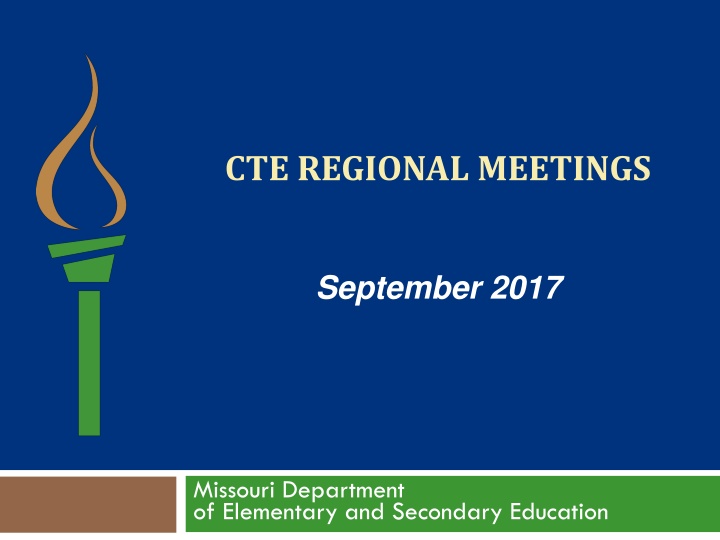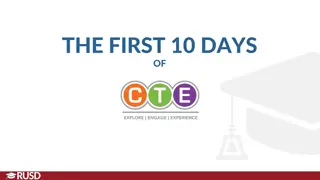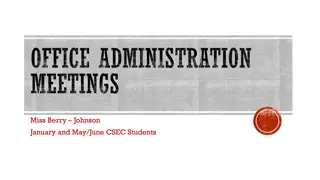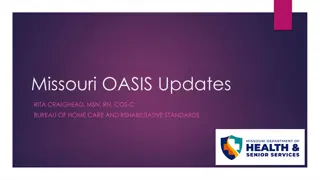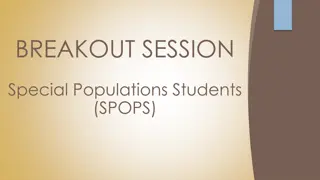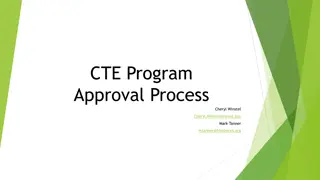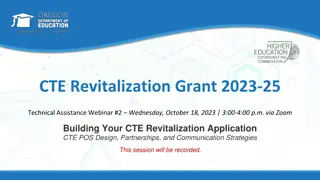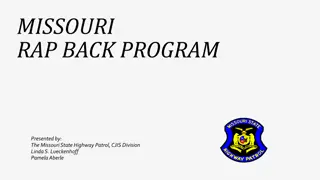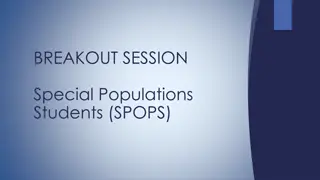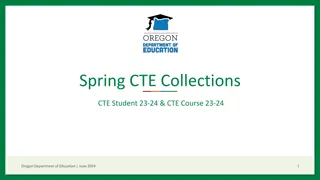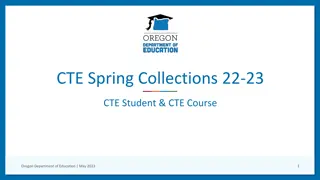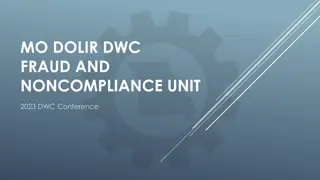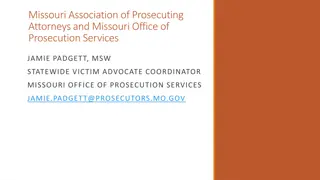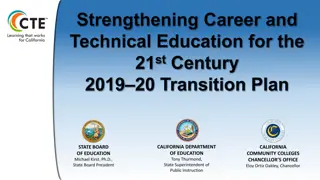Missouri CTE Regional Meetings September 2017 Overview
Images and descriptions from the Missouri Department of Elementary and Secondary Education's CTE Regional Meetings in September 2017. The meetings covered topics such as CTE funding, high-quality CTE programs, and the purpose of the regional meetings. Details about the current funding structure, the formation of an ad hoc advisory committee, and new funding strategies were discussed during the meetings.
Download Presentation

Please find below an Image/Link to download the presentation.
The content on the website is provided AS IS for your information and personal use only. It may not be sold, licensed, or shared on other websites without obtaining consent from the author.If you encounter any issues during the download, it is possible that the publisher has removed the file from their server.
You are allowed to download the files provided on this website for personal or commercial use, subject to the condition that they are used lawfully. All files are the property of their respective owners.
The content on the website is provided AS IS for your information and personal use only. It may not be sold, licensed, or shared on other websites without obtaining consent from the author.
E N D
Presentation Transcript
CTE REGIONAL MEETINGS September 2017 Missouri Department of Elementary and Secondary Education
Topics 3 CTE Funding High Quality CTE Programs CTE Certificate
Purpose of CTE Regional Meetings 4 Provide LEAs with an understanding of how state CTE funding will be calculated and distributed beginning with the 2018-19 school year. Discuss High Quality CTE Programs Provide LEAs with the opportunity to ask questions regarding the new CTE certificate.
CTE Funding Current funding structure in place since 2001 Charge from Department Leadership to review current funding and develop a new plan for redistribution of state CTE funding. New funding plan in place for the 2018-19 school year
CTE Funding 7 Convened CTE Ad Hoc Advisory Committee Area Career Center Directors CTE Teachers High School Principals Superintendents Higher Education Representatives 2- and 4-year State Technical College of Missouri
CTE Funding 10 Facilitated by Central Comprehensive Center, College and Career Readiness and Success Center, and Center on Innovation in Learning in conjunction with staff from OCCR. Seven meetings held over a 10-month time frame (6 face-to-face and 1 webinar)
CTE Funding 11 New Funding Strategies Comprehensive High Schools Area Career Centers Postsecondary Adult Use Common Criteria and Quality Indicators as basis for funding eligibility (Phase in)
Area Career Centers (ACCs) 13 ACCs will receive base funding to assist with the costs of implementing career and technical education programs. Funding can be used as follows: Offset salary of CTE teachers, CTE counselors and CTE administrators Equipment purchases cannot be used as match for other state CTE programs, ie. 50/50 Equipment and Resource Grants, Vocational-Technical Enhancement Grants, etc. Supplies Professional Development Other expenditures that the district deems appropriate to support CTE programs (See State CTE Grant List of Allowable and Unallowable Costs)
ACC Funding 14 Three Components: 1. Core Support 2. Career Ed Time Devoted (CTD) 3. Student Credits Earned
Core Support 15 Each Area Career Center will receive core support of $75,000.
Career Ed Time Devoted (CTD) 16 The Department will use the October Cycle in Core Data Educator (Screen 18) and Course & Assignment (Screen 20) to obtain the educator FTE and CTD data. The Department will total the FTE and CTD for educators at each LEA who are properly certificated and teaching DESE approved CTE programs. The Department will multiply the total CTD for each LEA by $2,500.
Student Credits Earned 17 The Department will use the June Student Course Completion file in MOSIS to obtain the credits earned data. The Department will total the number of credits earned for each LEA (credits will be capped at 1,750). The Department will then divide the LEA s number of credits earned by the state-wide total of credits earned in order to calculate a credits earned percentage. The Department will multiply the credits earned percentage for each LEA by the total funds available for CTE Base Funding.
Rationale 18 Core support funding is the same for all 57 area career centers. Provides support for teachers, which is consistent with the funding for comprehensive high schools. Provides additional support through CTE credits earned that rewards area career centers for students served and courses offered. Keeps area career centers operating at or near their current level of state funding. Consistent with current programming being offered.
3-Year Phase In Area Career Centers Only 19 3-year phase in will be based on 2016-2017 data only. 2018-19 Gain/Loss amount received is 1/3 of the difference between the new calculation and 2008 allocation 2019-20 Gain/Loss amount received is 2/3 of the difference between the new calculation and 2008 allocation 2020-21 Gain/Loss amount received is the 2016-17 calculation
Comprehensive High Schools (CHSs) 21 CHSs will receive base funding to assist with the costs of implementing career and technical education programs. Funding can be used as follows: Offset salary of CTE teachers, CTE counselors and CTE administrators Equipment purchases cannot be used as match for other state CTE programs, ie. 50/50 Equipment and Resource Grants, Vocational-Technical Enhancement Grants, etc. Supplies Professional Development Other expenditures that the district deems appropriate to support CTE programs (See State CTE Grant List of Allowable and Unallowable Costs)
CHS Funding Calculation 22 CTE Base Funding for CHSs will be calculated as follows: The Department will use the October Cycle in Core Data Educator (Screen 18) and Course & Assignment (Screen 20) to obtain the educator FTE and CTD data. The Department will total the FTE and CTD for educators for each LEA who are properly certificated and teaching DESE approved CTE programs. The Department will then divide the LEA s number of CTD by the state-wide total of CTD in order to calculate a CTD percentage. The Department will multiply the CTD percentage for each LEA by the total funds available for CTE Base Funding.
Rationale 23 Provides support for CTE teachers in comprehensive high schools that recognize the growth in CTE programs in this particular venue. Funding at the comprehensive high school now includes Family Consumer Sciences (FCS) and Human Services teachers. PLTW courses are not included in funding calculations. Note: The goal is that the allocation per FTE CTE will be maintained at an amount of at least $2,500.
Reminders 25 All CTE teachers must be properly certificated. Personal Finance teachers must have certification in Business or Family Consumer Sciences to be included in the funding calculation. All CTE courses must be listed on the DESE Approved Course List. Educator Data will be pulled from previous school year s October Assignment for Educators. PLTW courses are not included in funding calculations.
Reminders 26 June Student Course Completion file will be used to calculate the sum of credits earned. Must report appropriate CTE Program Type Use Position Code 60 Student Grade Level can only be 09, 10, 11, or 12. Do not use grade level 13. Student Grade Earned must be an A, A-, B+, B, B-, C+, C, C-, D+, D, D-
Reminders 27 FTE-Career Time Devoted (CTD) Calculation FTE comes from Core Data Screen 20 CTD 1 count all courses approved in CTE for the educator s assignments. Requires 01 populated in the course program code. CTD 2 count all courses in the educator s assignments (CTE, non-CTE, and non-teaching assignments)
Reminders 28 As per the Core Data/MOSIS Manual: The district and school where the educator provides instruction or services will report Course Assignment records.
Postsecondary (Two-year and Four-Year Institutions) 30 Postsecondary institutions will receive base funding to assist with the costs of implementing career and technical education programs. Funding can be used as follows: Offset salary of CTE teachers, CTE counselors and CTE administrators Equipment purchases cannot be used as match for other state CTE programs, ie. 50/50 Equipment and Resource Grants, Vocational-Technical Enhancement Grants, etc. Supplies Professional Development Other expenditures that the institution of higher education deems appropriate to support CTE programs (See State CTE Grant List of Allowable and Unallowable Costs)
Postsecondary Funding Calculation 31 CTE Base Funding for postsecondary institutions will be calculated as follows: The Department will use the PS/Adult Course Assignment file in MOSIS to obtain the credit hour data. The Department will total the number of credit hours taught in DESE approved CTE programs for each LEA. The Department will then divide the LEA s number of credit hours by the state-wide total of credit hours in order to calculate a credit hour percentage. The Department will multiply the credit hour percentage for each LEA by the total funds available for CTE Base Funding.
Rationale 32 Provides support for CTE programs at the postsecondary level. Recognizes the growth in CTE programs by awarding funds based on CTE credits offered.
Adult 34 Base funding will be provided to assist with the costs of implementing adult programs (both full- time and short-term). Funding will be used to offset salaries of instructors only. Priority will be given to full-time adult programs. Short-term adult funding will be based on availability of funds.
Full-Time Adult Funding Calculation 35 The Department will use the PS/Adult Course Assignment file in MOSIS to obtain the instructor and contact hour data. The Department will total the number of educators at each LEA who are properly certificated and teaching 500 or more contact hours of instruction in DESE approved CTE programs. The Department will then multiply the LEA s number of full-time educators by $15,000.
Short-Term Adult Funding Calculation 36 The Department will use the PS/Adult Course Assignment file in MOSIS to obtain the instructor and contact hour data. The Department will give funding priority to CTE programs in high demand occupations. The LEA must complete and submit a Short-Term Adult Application. For programs approved for funding, the Department will multiply the educator s number of contract hours of instruction by $10 (Up to 499 contact hours of instruction)
Rationale 37 This approach continues the long-standing support of training adults for new careers and skill upgrades.
CTE Performance Funding 39 ACCs and CHSs will receive CTE Performance Funding (formerly Effectiveness Index Formula) for CTE programs that achieve success in positive placement of program completers (based 100% on placement).
CTE Performance Funding 40 CTE Performance Funding will assist with the costs of implementing career and technical education programs. Funding can be used as follows: Offset salary of CTE teachers, CTE counselors and CTE administrators Equipment purchases cannot be used as match for other state CTE programs, ie. 50/50 Equipment and Resource Grants, Vocational-Technical Enhancement Grants, etc. Supplies Professional Development Other expenditures that the district deems appropriate to support CTE programs (See State CTE Grant List of Allowable and Unallowable Costs)
Funding Calculation 41 CTE Performance Funding will be calculated by: Totaling the number of completers that were positively placed in employment, continuing education, or military. The positive placement percentage will be calculated by dividing the LEA s number of completers that were positively placed. The positive placement percentage is then multiplied by the total funds available.
Tentative Timeline 42 September 2017 release estimates based on 2016 data. October 1, 2017 March 31, 2018 LEAs review 2016-17 data to ensure accuracy April 2018 DESE prepares LEA budgets May 2018 DESE releases 2018-19 budgets
Common Criteria and Quality Indicators (CCQI) Developed over a two-year time span by DESE CTE Program Staff Based on work done by Southern Regional Education Board and other research focused on CTE quality programs. Reviewed and recommended approval by the Interim CTE Advisory Committee Formal release in July 2015 Revised July 2017
Common Criteria Common Criteria Programs of Study Curriculum Instruction Assessment Career and Technical Student Organizations 5 Program Management and Planning # of Quality Indicators 4 3 8 3 4
Evaluation and Program Improvement Tool Three Parts to Evaluation and Program Improvement Tool: Rubric Suggested Documentation Program Improvement Template
CCQI Tentative Timeline 48 2017-18 School Year pilot year for CCQI Year 1 (Pilot Year) all LEAs complete CCQI for each approved CTE program. No supporting documentation and/or evidence required. Year 2 (2018-19 School Year) Cohort II LEAs would resubmit CCQI with documentation and/or evidence. Year 3 (2019-2020 School Year) Cohort III LEAs submit CCQI with documentation and/or evidence.
CCQI Timeline (Cont.) 49 Tiered Monitoring System will be available October 1, 2017 March 31, 2018 (Tentative)
